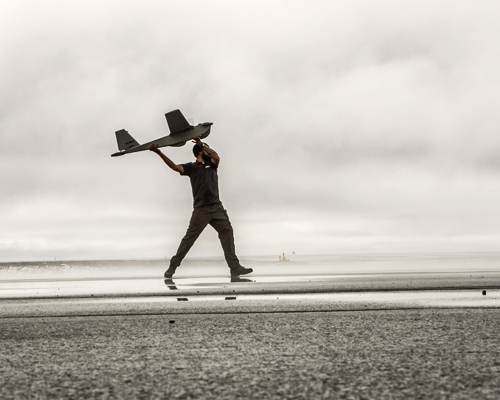
The Federal Aviation Administration’s recent approval of BP’s flights of a commercial unmanned aircraft system (UAS), or drone, over northern Alaska, which began on June 8, is a step toward legalizing commercial UAS flights elsewhere in the nation. Until now, legal commercial use of UAS over land has been restricted to the military, law enforcement and scientists engaged in research and development.
FAA spokesman Les Dorr says the agency is talking to commercial industries “to expand commercial unmanned aircraft use” of small drones now, with an eye to issuing exemptions to existing regulations before new policies are set in place later this year.
Industrial users, including operators of precision agriculture systems and inspectors of oil and gas facilities, particularly flare-stacks, are hoping for such exemptions, although no companies in those industries, other than BP, have applied for exemptions so far.
BP and drone manufacturer AeroVironment will use the Puma AE’s aerial imaging capabilities to scout 200 miles of roadways, traversed by 3.5-million-lb drill rigs, and assist rig operators in low-visibility conditions, in addition to surveying pipelines and a gravel pit.
According to Dorr, the FAA is exploring the possibility of issuing additional commercial authorizations before formal policies are set, based on its authority under the FAA Modernization and Reform Act of 2012, Section 333. He says issuing exemptions under Section 333 would let the FAA loosen one restriction impeding commercial development, which is that the agency can authorize only UAS flights that employ aircraft the FAA already has certified for commercial flight.
Only two models of UAS now pass that test: AeroVironment’s Puma AE, now in use for the BP flights, and Insitu’s Scan Eagle, which was used under an earlier permit over Arctic waters in 2013. Both have been tested previously and used by the U.S. military, the current standard held by the FAA.
Other FAA requirements that must be met for UAS commercial use say applicants must have a licensed pilot-operator and approval for the specific time, location and duration of the flight. Pilot-operators do not have to have UAS-specific training, however.
Exemptions under Section 333 are currently sought by seven video production companies working with the Motion Picture Association of America. A decision is expected within four months.
BP’s first flight under a five-year contract was performed by AeroVironment, the manufacturer of the Puma AE.
The Puma AE, or "all environment," is a hand-launched UAS with a 9.2-ft wingspan and an operating range of 20 kilometers. It weighs 13.5 lb and can fly at speeds of 20 to 50 mph for up to three and a half hours.
Both the Puma AE and Insitu’s Scan Eagle have been issued Restricted Type Category Certificates, which outline their specific, allowed commercial use, according to an FAA spokesman.


Post a comment to this article
Report Abusive Comment